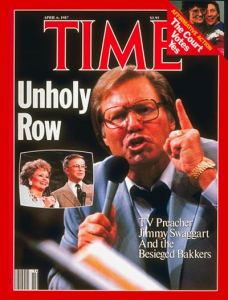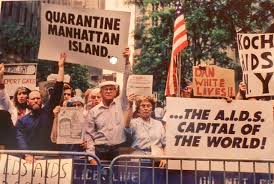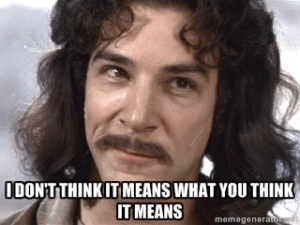
St. John’s UCC in Kutztown, PA
In preparing for the oral presentation on Keith Haring, I was especially interested in the prevalence of Christian religious symbols in his work. I wanted to understand more about his religious influences. So, I thought I’d visit the Haring family church, St. John’s United Church of Christ in Kutztown, Pennsylvania. The church’s website indicates a long tradition of American protestant worship and community service. There didn’t seem to be any remarkable evidence of the kinds of crosses, angels, and devils which constitute much of Haring’s visual vocabulary. The website reports a tradition of promoting social justice which may have shaped Haring’s use of art as a medium for exposing social injustice. But, Haring’s church life during his early years doesn’t fully explain the religious imagery in his work, at least not as far as I could tell.

Camp Mensch Mill from Facebook. Not sure of date, probably sometime in the 1950s. Keith may not have been born yet.
The next stop I took was the church summer camp Haring and his mother mention in the documentary, The Universe of Keith Haring. The regional United Church of Christ summer camp associated with St. John’s UCC would have been the Southeastern Pennsylvania Conference camp, Mensch Mill, currently up for sale. In the documentary, Haring’s mother described Keith’s experience at the camp as one of his first experiences with people with backgrounds different from his own. Her observations are clearly supported by the following:
For eighty-four years, the mostly wooded area of Mensch Mill was home to summer youth camps, workshops, and retreats. Mensch Mill staff welcomed diverse groups seeking to “provide an intermingling of varied backgrounds, cultures, races, and experiences in which individuals can develop an awareness and concern for society’s issues” (from “A Working Paper on Church Camping,” by Rev. William H. Solly, Minister of Camping for the PSEC of the United Church of Christ, 1973-1979).
So, maybe Mensch Mill and St. John’s UCC helped to shape Haring as an artist with a “concern for society’s issues,” but Haring’s church and church camp experiences may not solely account for the vivid visual religious symbolism which peppers Haring’s art.
Natalie Phillips, in her article “The Radiant (Christ) Child,” attributes Haring’s depiction of crosses, holes in the abdomen, angels, devils and other religious apocalyptic signs to his brief attraction to and involvement with the Jesus Movement during his early teen years. Phillips references Duane Pederson’s Hollywood Free Paper as a possible source of Haring’s imagery. In his own words from Keith Haring: The Authorized Biography (1991) by John Gruen, about the Jesus Movement, Haring states:
Finally, I myself became bored with it. I had done it for about a year, and it seemed to make less and less sense to me, and it became less pressing… and I don’t know that I ever, really believed all those things. It wasn’t as exciting as it appeared to be at first. Still, all that stuff stuck in my head and even now there are lots of religious images in my work, although they’re used in a more cynical way – to show how manipulative those beliefs and images can be.
 Another possible source for Haring’s Christian religious imagery might be the very heart of Haring’s world. Keith Haring may not have needed to rely on his religious upbringing for source material. He could have turned on his television and found televangelists like Jim Bakker and Jimmy Swaggart peddling their version of Jesus to folks across the country before they both made a public fall from grace.
Another possible source for Haring’s Christian religious imagery might be the very heart of Haring’s world. Keith Haring may not have needed to rely on his religious upbringing for source material. He could have turned on his television and found televangelists like Jim Bakker and Jimmy Swaggart peddling their version of Jesus to folks across the country before they both made a public fall from grace.
He likely walked the streets of New York City and saw people carrying posters proclaiming pro- military, homophobic, capitalistic messages using Christian symbols and rhetoric. The times called for artists to refute those messages by using the same symbols.
military, homophobic, capitalistic messages using Christian symbols and rhetoric. The times called for artists to refute those messages by using the same symbols.
During the 1980s, there seemed to be an emerging tradition of pop artists to adopt the religious symbols of the Religious Right, which held a period of political dominance in the United States, in an effort to confront hate-filled religious sensibilities. It was as if pop artists held up the same religious symbols to say, in the words of Inigo Montoya, character in the 1987 movie Princess Bride:
Madonna, Haring’s friend, was a prime example of another pop artist using religious symbolism to critique Christian religious fundamentalism.
However Keith Haring wove his religious influences into his artwork, he clearly exhibited a social conscience perhaps drawn from his own sense of the crossed lines intersecting art and spirituality. Quoted from Keith Haring: The Authorized Autobiography, Keith says:
I think as much as possible, an artist, if he has any kind of social or political concern, has to try to cut through those things, and to expose as much as possible what he sees so that some people think about things that they don’t normally think about. Sometimes I do that by pushing things to the extreme; in the face of people who try to close their eyes I react the opposite, by trying to be more open and deal more openly with sexuality and violence for instance. An artist putting as many images into the world as I am should be aware or try to understand what that means and how those images are absorbed or how they affect the world. I don’t think art is propaganda; it should be something that liberates the soul, provokes the imagination and encourages people to go further. It celebrates humanity instead of manipulating it.


















































































I share your questions regarding Haring’s intentionality about spirituality in his works. It seems to me that it might have been “just how he thought” about things as a result of his childhood and early adulthood experiences with church, religion, spirituality. The final quote of your post resonates with me and my own inquiry into Haring related to “The Marriage of Heaven and Hell” – an ethical stance for social change, a prophetic vision that he gave his life for: ” An artist putting as many images into the world as I am should be aware or try to understand what that means and how those images are absorbed or how they affect the world. I don’t think art is propaganda; it should be something that liberates the soul, provokes the imagination and encourages people to go further. It celebrates humanity instead of manipulating it.”
LikeLiked by 1 person